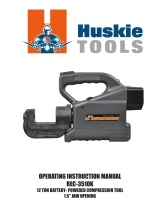
8
MOUNTING THE HAMMER TO THE CARRIER
1. Skid Steer Loader
All hammers are mounted to hammer brackets, which are then mounted to an adapter
plate using two pins. The adapter plate is mounted to the quick mount of the carrier. To
remove the hammer, first disconnect the hydraulic couplers from the inlet and outlet ports
and detach the quick mount. Seal off all plugs and hoses to prevent dust, dirt and foreign
particles from entering the system.
2. Rubber-Tired Backhoes and Excavators
All hammers are mounted to hammer brackets. The hammer brackets are mounted to the
stick of the carrier using two pins and four bushings. To remove the hammer, first
disconnect the hydraulic couplers from the inlet and outlet ports. Seal the couplers and
hoses to prevent dust, dirt, and foreign particles from entering the system. Remove the
“mounting pins” to detach hammer and bracket from the carrier stick.
CONNECTING HOSES
Connect the two hydraulic hoses to the inlet and outlet ports of the carrier using hose
couplers. When connecting, make sure that the couplers are clean and engaged securely.
DAILY INSPECTION BEFORE OPERATION
1. Check the carrier hydraulic oil level before operation. The hydraulic oil level must be
correct for proper operation.
2. Check the hydraulic oil for any signs of contamination or discoloration. If any signs
of contamination appear, change the oil. (Refer to Table 2, Page 13)
NOTE: Do not mix different types of hydraulic oil.
3. Inspect all hoses and fittings for leaks or damage. Check all fasteners and tighten as
required. Replace any broken fasteners.
4. The hammer must be greased daily before use. Ten shots of grease with a grease gun
is adequate. The hammer should be greased every 2-3 hours during operation. (See
Figure 2)
5. Check the temperature of the hydraulic oil. Optimum operating temperature is 120°/
200° F (49°/93°C). The unit may not function properly and seal damage may result if
the hydraulic oil temperature goes beyond the recommended range.
Figure 2. Hammer Lubrication Point

























